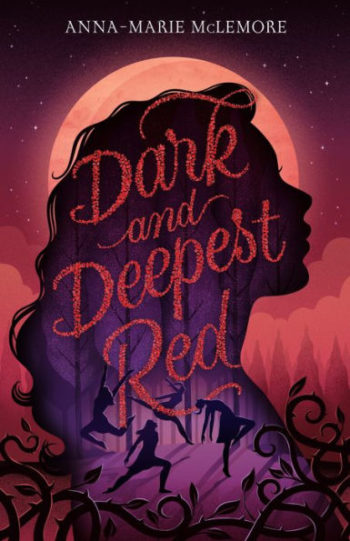The examination of identity—especially race, gender, and sexuality—appears in all of Anna-Marie McLemore’s books. Lace becomes the thing she fears the most and must rewire her old perceptions. The Nomeolvides women live in a garden that is both a blessing and a curse because others fear their power and brown skin. Blanca and Roja reject the identities placed upon them by others and forge their own. Samir wants to be someone he isn’t while others try to force Miel to change who she is. All of these strands are braided together into something harder and stronger in Dark and Deepest Red.
Strasbourg, 1518. Lala and her tante hide in plain sight. No one can know they are Romani, so they practice their beliefs in secret and hope the light-skinned townsfolk will overlook their darker tones. They coast for a while. A runaway boy, Alifair, joins their household and bonds with Lala. Tante becomes a respected dyemaker. Lala makes friends, albeit ones who know nothing about her. Until a young woman dances herself to death in the city center. Then another. Then another. Until hundreds are dancing as if possessed. Suspicions and accusations spread quickly, and Lala finds herself at the center of it all.
Five hundred years later, Emil, Lala’s distant descendant, pines for Rosella, the daughter of Mexican American shoemakers. Once a year for a few weeks in the small town of Briar Meadow, a glimmer appears over the lake. People lose inhibitions, animals act strangely, and relationships bloom and burst. This year the glimmer takes hold of Rosella’s red shoes, and the dancing plague begins anew. The only way to help Rosella is to reopen the wound from Emil’s past and learn the truth about what really happened in Strasbourg.
Or, in the words of the author themself: “The very short description is ‘Red Shoes’ plus medieval queers… [A different] way to describe it would be a reimagining of the fairy tale ‘The Red Shoes’ through the lens of the 1518 dancing plague. And another way I like to talk about it is sort of the secret history of a fairy tale.”
This is a love story, as all of Anna-Marie McLemore’s novels are, but the love sprouts from the seed of identity watered by oppression and marginalization. Emil and Rosella are different ethnicities but deal with similar bigotries and stereotypes. They adopt middle-class WASP-y traits and habits to mask their brown features and non-Western beliefs. Emil actively ignores his familial history as if not knowing about his past makes it cease to exist. Rosella styles her hair like white girls and hides her family’s cultural traditions.
Rosella and Emil do all this to survive, just as Lala and Alifair do 500 years earlier, but it takes a toll. They hide who they are because they know how the townsfolk will react, what they will be blamed for, what they will be punished for—they know in the same way all marginalized people know what the majority does to those who are different. This is not a hypothetical exercise for Emil, Rosella, Lala, or Alifair. They know because they (we, I) have seen it and experienced it.
On their twitter, Anna-Marie McLemore wrote about “the strange and unsettling magic” of figuring out they were gender fluid while wrapping up Dark and Deepest Red. They describe how understanding your identity is a journey you may not even realize you’re taking until you’ve already turned a corner. My journey to coming out as asexual and aromantic is not that dissimilar from Anna-Marie McLemore’s. Decades of trauma and shame—not to mention the lack of terminology and social awareness—made it impossible for me to see the signs which now I realize were so obvious. I circled around my identity without even realizing it until one day the path cleared and I could finally move forward.
Accepting myself was freeing and terrifying; coming out was both to the extreme. I still come out nearly every day. For many of you, I’m coming out right now. It was a long road to get where I am today and the journey is still going. My queerness isn’t in flux, but where I fall on the ever-shifting spectrum is. This, too, is a whirlwind of contradictory feelings: awful and wonderful, excruciating and exhilarating. I have been Lala, taking my first steps toward reckoning with an identity that will not be denied. I have been Alifair, standing tall and true against those who believe themselves my judge, jury, and executioner. And I have been Emil and Rosella, walking a path with an unknown destination but unable and unwilling to step off it.
This is the power of Anna-Marie McLemore. They don’t just tell a story, they pick you apart, prying muscle from bone and blood from viscera until they find the thing you didn’t want to feel or think about or acknowledge and force you to confront it. I saw myself in Dark and Deepest Red just as I’ve seen myself in their other books. I cried reading Dark and Deepest Red. Although it’s something I rarely do, it’s actually not that unusual with Anna-Marie McLemore. I’ve cried during each of their books. But this one left the biggest mark on my soul.
Anna-Marie McLemore has an incandescent talent that burns brighter and hotter with each novel. Their latest will break your heart and stitch it back together again and you’ll enjoy every single moment. In a bibliography full of exceptional novels, Dark and Deepest Red transcends them all.
Dark and Deepest Red is available from Feiwel & Friends.
Alex Brown is a teen services librarian by day, local historian by night, author and writer by passion, and an ace/aro Black woman all the time. Keep up with her on Twitter and Insta, or follow along with her reading adventures on her blog.










